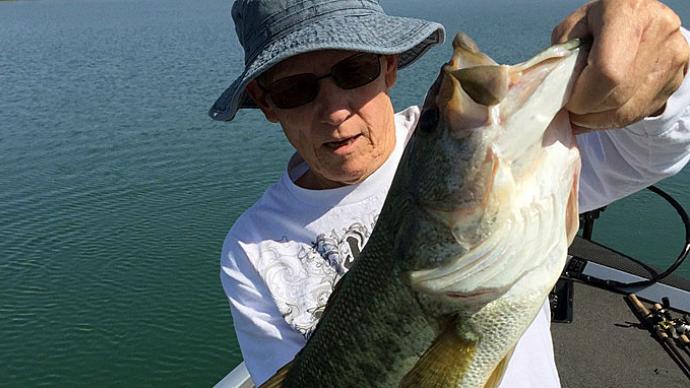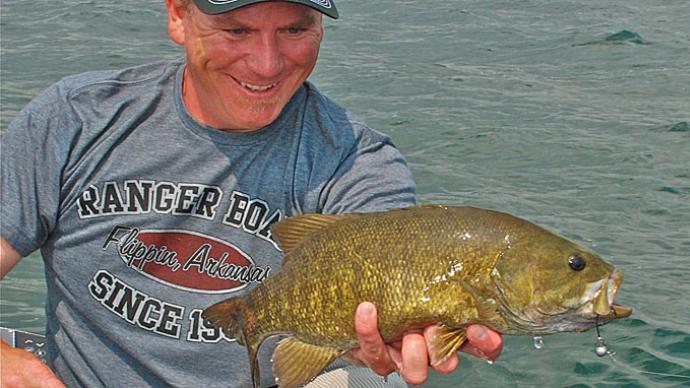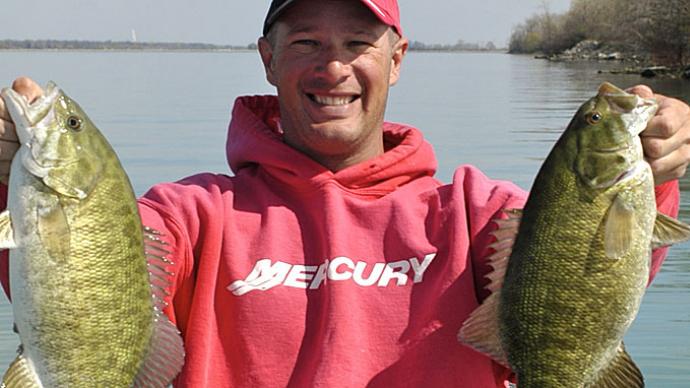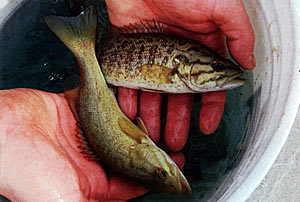
Smallmouth bass are renowned for their leaping ability and fast-driving, pit bull-like fights. Are you interested in raising a thriving, reproducing population of smallmouth bass? If you are, then one of the important first steps is to provide proper areas for these fish to build their nests. Research has shown certain physical features of a nest will definitely improve the ability of parental bass to produce more fry that may result in more fingerlings for your pond.
Gee, your pond seems to have lots of fingerling and 8-inch smallies? How did that happen? Smallmouth bass in my pond do not spawn. Shoot, smallmouth bass don't successfully spawn in most ponds. Well then, partner, read on and we will give you some helpful suggestions for spawning and raising more smallmouth bass.
The nuances of smallie spawning sites are interesting. One study found most nest locations of smallies were on the west and north shores (Becker 1983). Another study concluded areas sheltered from direct wind and wave actions resulted in the most nests. In small ponds near my home base of northwest Ohio, smallmouth bass do not seem to prefer one shoreline compared to another. I have found smallmouth nests on the northern, southern, eastern, and western shorelines. From my observations, the correct types of bottom materials placed at the correct water depth are the two most important items for successful spawning of smallies.

Spawning Ages
Various reports exist about when smallmouth males reach sexual maturity. Most articles report maturity is reached in the third or fourth year. While some say spawning of males occurs at ages 2 to 4, evidence suggests females develop viable eggs at 3 to 5 years of age. Newer information indicates size, rather than age, determines when smallmouths reach sexual maturity. Males often spawn the first time at a size of 7.5" to 10" and females at 10" to 12" (Wallus and Simon 2008). A male as small as 7.2" was seen guarding a nest in Virginia.
Pre-Spawn Activities
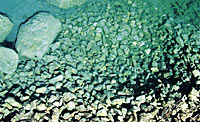
As is the case with sunfishes and basses, the male is responsible for nest site selection, construction, guarding eggs and fry. Largemouth bass will use lots of different types of substrates for nests. Largemouth bass often start their nests by sweeping a thin layer of soft muck off the pond bottom and then clean a crater-shaped area to expose hard bottom that might include roots, twigs, gravel, sand, with clam and snail shells.
When available, smallies almost always choose a nest location that has fewer plant materials and that contain coarse sand, gravel, rock rubble, and sometimes even just bedrock. When given a choice of a variety of substrates to build a nest, smallies usually choose coarse gravel or gravel mixed with rocks, larger stones or rock rubble. The best rocks and rubble range from the size of quail eggs to fist sized cobble. Older males often use their old nest or choose a site close to last year's nest.
In an older small pond near me that has had smallies as the main predator for 19 years, new nest sites have not been excavated for many years. In this pond, smallie nests of older larger males are never constructed in the beach area containing crushed No. 9 stone (1/8" to 1/4"). Here, active nests are always in old excavated depressions along shorelines that have 1" to 3" limestone.
In contrast, in another similar-sized pond containing only smallies to 13", the nests have always been in the area containing pea gravel (3/16" to 1/2"). In this pond, during the last 5 years, I have never observed nests in the larger sized limestone rock along the shoreline. In this pond, in late fall before the spawn of 2008, I created several ideally designed depressions in the 1" to 3" rocky shoreline to see if bass would use them for nests. In the depressions, I placed one or two large rocks or cement blocks at the edge or rim. The next spring, the only two active nests I saw were in the pea gravel beach area. I concluded either the small sized bass in this pond were "creatures of habit" and preferred the old nest sites or it is primarily the larger males that prefer to use the larger sized materials for nest sites. Smaller sized bottom materials would make it easier for small males to create a saucer shaped depression for a nest.
In The Mood
Smallies typically spawn about 10 days before largemouths. Not all mature male smallies excavate nests each year. A couple studies have shown that often less than one-half of the males build nests and sometimes only 25% of the males will build nests in any given year (Bayliss et al 1993, Hoff 1991). These studies found the larger, more experienced males tended to produce more successful nests compared to smaller, younger males.
When water temperatures reach 59 or 60F, the male starts cruising the shallows in 2 to 5 feet of water as he looks for vulnerable food items and inspects for a suitable nest location. Smallie nests have been found in a wide variety of waters as shallow as 10 inches and up to 10 feet deep.
After several warming periods and waters warm to stable temperatures of 62 to 64F, the male chooses a site and begins nest construction. A few smallies have been seen spawning at 70F. If there is a water temperature drop of just 5 to 8 degrees the male will often desert the nest, even if it has eggs in it.
Observations revealed most nest construction occurs in early morning. The circular depression created for the nest most often ranges from 12" to 70" across and is excavated 2" to 4" into the bottom materials. Sometimes the male will abandon the first construction site and then build a second one that usually serves as the final nest.
Time spent building the nest ranges from 4 to 48 hours. Construction time depends a lot on if the male is building the nest in a new undisturbed area that needs a lot of cleaning or is using an older, relatively clean nest site.
When given a choice, the male will most often choose an area with preferred bottom material near some form of cover. Cover can be most any form of large object or structure such as a boulder, log, large tree limb or an underwater crib. I think smallest mature males generally choose a nesting bottom with smaller materials such as coarse sand or small gravel compared to larger males that can more easily dig and excavate in larger, coarser substrates.
In talking to other pond owners, smallies seem to be pretty flexible in their spawning habits. Sometimes when conditions are just right, they nest twice in one season or spawn once later in the season. Early research revealed smallie females often contain eggs with different developmental stages (Reighard 1906). If the first nest fails to produce fry, the male will sometimes attempt to spawn a second time. Cooler air and water temperatures later in the season sometimes initiate a second spawn. However, I have not observed this in any of the small ponds located near me. But others with smallies have told me that later in the summer they sometimes get an isolated spawn from their smallies.
Building a Nesting Area
Numerous studies have shown smallies are cover oriented and instinctively orient themselves with darker colors, objects, shapes and even shadows. That is one of the reasons smallies often prefer to build nests near a large rock or under a board or over-hanging log. Typical cover types are boulders, logs, stumps, boards, docks or other bulky submerged objects. One study found concrete blocks placed on gravel were accepted as nest locations.
Several studies reported smallies prefer relatively open water sites and avoid building nests in or near sites that contain dense or complex structures such as brush piles. Authors of those studies think complex structure adjacent to the nest allowed more small fish and sunfish predators protection as well as quick access to raid the nests. This makes defending the nest more difficult. Smallie nests have even been found in rooted submerged weed beds, but this is rare.
Another study that used simple half-log structures in spawning areas of three lakes to improve nesting of smallies resulted in increased nesting success by 137% to 287% (Hoff 1991). The number of nests containing eggs or fry increased 183% to 443% compared to similar lakes with natural cover only. Production of juvenile smallies in lakes with these nesting structures increased 607% to 3,844% compared to the lakes before half logs were installed.
Half log structures are inexpensive, simple and easy to make. Half log shelters are made of hardwood planks 9" to 12" wide and supported about 16" above the bottom with masonry blocks at each end. Most of the nests built near the half-logs were directly below the log or within 12 feet of them, so place these structures in the nesting areas for your smallies.
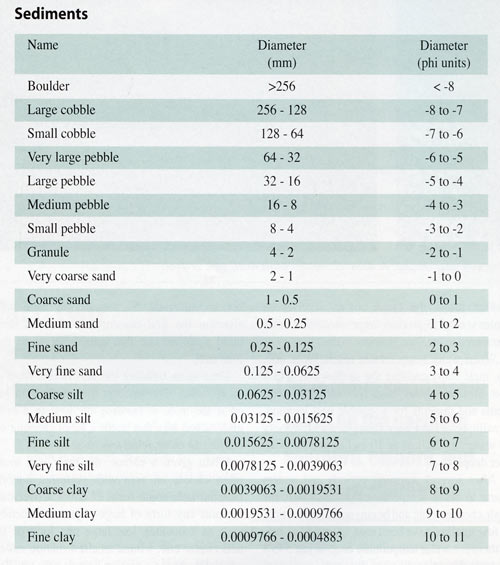
Smallie nests in Bull Shoals Lake were always at least 30 to 100 feet apart. However in a local 0.3 acre Ohio pond where smallies annually spawn, old nests are spaced from 10 to 30 feet apart. Not every nest depression is used each year. So if you build nest structures, we suggest that you place them at least 20 to 30 feet apart. A federal hatchery in Oklahoma recommended placing artificial nesting boxes at least 12 feet apart for smallies (Inslee 1975).

A simple structure such as a box of gravel in a mud bottomed pond has been used by some hatcheries to produce successful spawns of smallies. A shallow tub of gravel mixed with larger stones with a half-log structure in 2 to 5 feet of water is sure to be used by a pair of spawning smallies.
More elaborate nests can be constructed using the suggestions in the two examples in this article. Include a larger rock or other structure as a beginning point. This fills the desire for the smallie to select a large object to be near the nest. In the examples, I added a piece of slab wood to provide the overhead cover that bass seem to prefer. Studies have shown that some form of simple structure at or near the nest also greatly improves survival of the fry. A large object at the nest provides the male a defendable position that offers him good visibility and limited approach from invaders. A tree top or brush pile at 50 to 100 ft distance from the nest is considered beneficial to survival of fry once they leave the nest.
Natural Rock, Cement Block
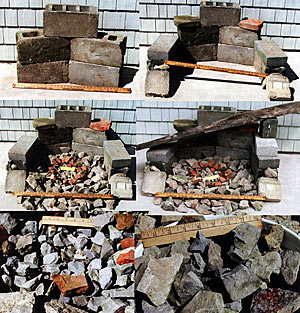
If present, largemouth bass will also use these nests to the exclusion of all the smallies. In small ponds with limited spawning areas, I think the male largemouth will chase male smallies off the nest so largemouth can use the nest for his spawning urges.
When building your smallie nest, remember to include some larger sized gravel or stones for central nest interior. Egg deposition areas in the center of the nest that provide cracks and grooves will create better refuge areas for protection of the eggs and the newly hatched yolk-sac fry before they are able to swim well and leave the nest.
Locate nest structures in 2 to 6 ft of water depth. Most smallie nests mentioned in the literature are found at around 3 to 4 ft deep. Depending on the size of the male the final nest diameter ranges from 1 ft to 4 ft across from rim to rim. Smaller males build smaller sized nests while larger males create larger nests.
Large active nests are always conspicuous in the spring because the interior, fine, loose materials are swept from the center to the outer edges.
In the next article I will examine smallmouth bass courtship, egg laying, and the development laying, the eggs and fry.
The author acknowledges the assistance and contribution of Eric West in the ideas and concepts included in and the research for this article.
Reprinted with permission from Pond Boss Magazine

